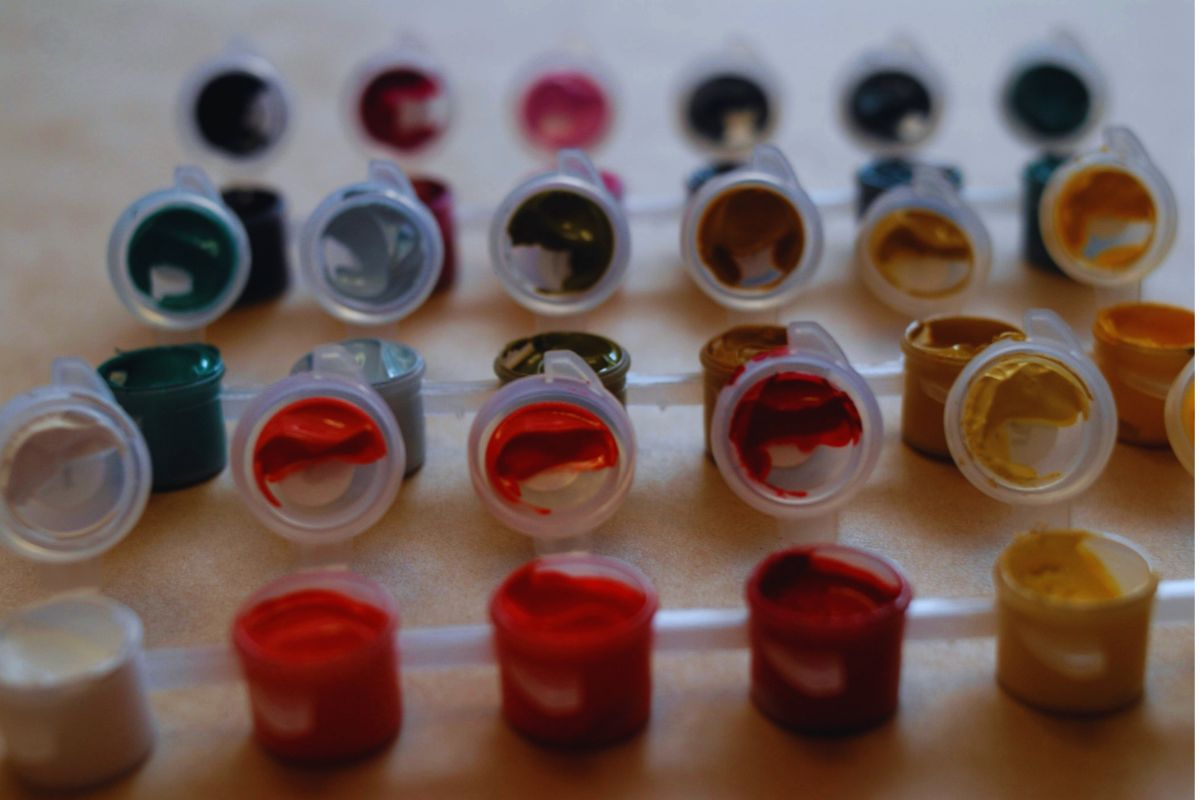Randy Charles is the owner of PaintCentric.com, a website dedicated to providing information, tips, tricks, and news about all things paint. With over 10 years...Read more
Acrylic paint on plastic? It’s like trying to make a vegan brownie taste like the real deal! To achieve a lasting and vibrant finish on your projects with acrylic paint, knowing how to seal it properly is essential.
Sealants like varnishes, sprays, and polyacrylics work well with acrylic paints on plastic. However, the type of sealant you use depends on your project and personal preference. Follow the sealant’s manufacturer’s instructions closely to get the most protection.
Leaving acrylic paint exposed to plastic can cause cracking or peeling. A top coat can prevent this without compromising the texture or appearance.
One crafter used a spray-on acrylic sealer to seal an acrylic-painted plastic vase. Even though she was unsure how it would turn out, she was amazed by how easy it was and how much longer her project lasted with the added protection.
Does Acrylic Paint Work on Plastic?

To ensure your acrylic paint adheres perfectly to plastic, you must first understand the properties of acrylic paints and plastic and how the two interact. That’s where this section, ‘Does Acrylic Paint Work on Plastic?’, with sub-sections on ‘Properties of Acrylic Paints,’ ‘Properties of Plastic,’ and ‘Compatibility of Acrylic Paints and Plastic’ comes in. Keep reading to learn more about these crucial factors and ensure your project succeeds!
Properties of Acrylic Paints
Acrylic Paints and Their Attributes
Acrylic paints are special. They are flexible and can be used on many surfaces, like plastics. Here are some essential characteristics of acrylic paints:
- Fast Drying: Acrylic paints dry quickly when exposed to air. It would be best if you worked fast with them.
- Water-Soluble: You can mix them with water to get a translucent effect.
- Versatile: You can use acrylic paint on canvas, paper, wood, and plastic.
- Permanent: When they dry, they become waterproof and don’t fade.
Before you start painting, make sure your surface is clean. It shouldn’t have dirt or dust.
It would be best if you worked in shorter sections. This way, each part will dry completely before you move on. This stops smudging and running.
We suggest using an acrylic paint primer base whenever possible. This will help the paint stick better and last longer. If that’s impossible, lightly sand down the plastic object to smooth the surface. This will help the paint stick better and last longer.
Plastic may last forever, but it’s no match for a determined hammer!
Properties of Plastic
Plastic is made of long-chain polymer molecules. It has many characteristics, like being durable, lightweight, flexible, corrosion-resistant, and non-biodegradable. It takes hundreds of years to decompose.
Here’s a table of plastic properties:
| Property | Description |
|---|---|
| Density | Light to heavy |
| Durability | Great |
| Strength | Depends on type |
| Flexibility | Depends on type |
| Heat Resistance | Varied degrees |
| Chemical Resistance | Varied by type |
The melting point of plastic depends on the type. It can be low or high. Knowing this is important when using acrylic paint, which needs heat curing.
Plastics were first invented in the 1800s as alternatives to natural materials like rubber and ivory. They have become popular and helpful in the automotive, packaging, construction, and healthcare industries.
Acrylic paint and plastic can make great art together.
Compatibility of Acrylic Paints and Plastic
Acrylic paint is an excellent choice for painting plastic due to its versatility and fast drying time. But, if the two are compatible depends on several things like the type of plastic, surface texture, and the quality of the paint.
Let’s check out the following table:
| Type of Plastic | Surface Texture | Acrylic Paint Compatibility |
|---|---|---|
| Polyethylene | Smooth | Poor |
| Polypropylene | Smooth | Fair |
| Polystyrene | Smooth | Good |
| PVC | Rough | Excellent |
Smooth surfaces don’t work too well with acrylic paints. But rough surfaces like PVC are superb for acrylic paint. Cleaning and sanding the surface before painting can help too.
A primer made explicitly for plastic can help with paint adhesion. Plus, thin layers of paint are better than one thick coat. It’ll reduce the risk of cracking or flaking of the paint.
In conclusion, acrylic paints and plastic can be compatible. But you need to prep the surface and pick the suitable plastic. With the proper process, you’ll get great results.
Is Acrylic Paint Good for Plastic?

To determine whether acrylic paint is a suitable medium for plastic, weighing its pros and cons is essential. To comprehensively understand this topic, we present the advantages and disadvantages of using acrylic paint on plastic. Considering these factors will help you to seal acrylic paint on plastic effectively.
Advantages of Using the Acrylic Paint
Acrylic Paint on Plastic – Pros to Note!
Using acrylic paint is a great way to upgrade plastics. It has many advantages, making it increasingly popular in many sectors.
- It adheres well, providing a smooth and long-lasting finish.
- Colors don’t fade like with other paints.
- It’s fast-drying, meaning you can complete multiple layers quickly.
- You can mix it with charcoal and ink to create unique styles.
Plus, you don’t need specialized tools or skills to use acrylic paint on plastic. A brush and a little knowledge will do the job!
But beware! Some plastics have non-stick or chemical components that can hinder adhesion. Clean and prime the plastic surface appropriately before painting.
Incorporating acrylic paint can make your plastic items look brand new! Try it out – you won’t regret it! But note: there are some negatives too.
Disadvantages of Using Acrylic Paint
Acrylic paint may not be the best for coloring plastic materials. It changes texture and color over time, reducing the item’s lifespan. It’s water-based and washable but can fade and deteriorate when exposed to heat or rain. Plus, it doesn’t stick to plastic surfaces well, often causing cracking or peeling. Oil-based paints have better strength and waterproof properties.
A primer is critical for durability. Solvent-based enamel paints designed for plastics are highly durable and resistant. My friend recently tried painting her vase with acrylic without proper guidance; it flaked off after two weeks. It showed why using acrylic on plastics requires knowledge. Remember: primer is like a good friend – it’ll help get you where you need to go!
Primer for Acrylic Paint on Plastic
It would be best to have a primer to ensure the successful adhesion of acrylic paint on plastic surfaces. Primer for Acrylic Paint on Plastic with the importance of primer, types of primers, and primer application as the solution will help you achieve the desired results. These sub-sections offer insights into the primer’s significance, the available varieties, and how to apply them for the best results.
Importance of Primer
Is it fostering Adhesion with Primer for Acrylic Paint on Plastic? Absolutely! Primer is vital for prepping plastic surfaces. It increases the ability of the surface to stick to the paint, making it more durable and resilient. Without primer, acrylic paint may peel or flake off. Primer provides a firm anchor for the color and stops it from moving around.
Different types of plastics need different primers. Acrylic-based primers are the most common, but there are also oil-based and solvent-based primers. Talk to suppliers to ensure you have a suitable primer for your plastic.
Application techniques also matter. Make sure surfaces are clean and free of contaminants before priming or painting. Scuffing or sanding plastic will help the primer stick better.
Allow enough time for drying between priming and painting. Without enough time, the paint won’t bond with the primer or previous layers. Give the primer at least 24 hours to cure before starting your acrylic colors.
Types of Primers
It’s critical to consider the various primer types when prepping a plastic surface for acrylic paint.
Adhesion Promoters bond securely but can be costly. Exterior Primers last in harsh outdoor elements but not for indoor use due to strong odors. Sanding Primers are cost-effective and easy to apply but take longer to dry and need multiple coats.
Don’t forget to clean the plastic surface before applying the primer. Research and select the correct primer option to ensure a successful outcome. Invest time in this for a top-quality finish on your acrylic-painted plastic items. Priming is like going to the dentist for your crafts!
Application of Primer
For a perfect paint job on plastic surfaces, you need primer! Primer seals the surface, enhancing paint adherence and longevity. Here’s a table of primer types and their optimum use:
| Types of Primers | Suitable for Surfaces | Drying Time | Coverage |
|---|---|---|---|
| Acrylic Primer | Non-porous, hard plastic surfaces | 30 mins – 6 hrs, depending on humidity & temp. | 1 Quart covers 120 sq ft. |
| Vinyl Primer | Soft vinyl & plastic surfaces | 30 mins – 6 hrs, depending on humidity & temp. | 1 Gallon covers 300 sq ft. |
Apply the correct primer type for the plastic surface. Ensure proper ventilation and safety gear while painting. Apply an even coating, and let each coat dry completely before applying the next one. Clean the surface of dust and grease before priming.
Sealing Acrylic Paint on Plastic
Sealing is crucial to ensure a lasting acrylic paint job on your plastic surface. To achieve this with ease, delve into the section “Sealing Acrylic Paint on Plastic” with the sub-sections “Importance of Sealing,” “Types of Sealers,” and “Application of Sealer” as solutions.
Importance of Sealing
Securing acrylic paint on plastic is essential for protecting the design and making it last longer. Sealing creates a barrier that guards the paint against moisture, UV rays, and other factors that may cause peeling and fading.
The type of sealant to use depends on the plastic’s surface finish. Glossy surfaces require oil-based sealants, while matte surfaces need water-based adhesives. Applying it depends on the Sealer used – spray, brush, or dip.
Poor quality or wrong sealants can lead to paint yellowing, discoloration, or cracking of the plastic over time. Make sure to purchase high-quality coatings suited for plastics to avoid damage.
A study by ‘The Journal of Coatings Technology and Research’ found that the proper sealant can increase the life of acrylic-painted plastic objects by 50%.
Sealing acrylic paint on plastic may seem challenging, but with the proper Sealer, your art will be as safe as a politician’s alibi.
Types of Sealers
Sealers for Acrylic Paint on Plastic come in various types. Here’s a breakdown of each one. Check out the table!
| Sealer Type | Description |
|---|---|
| Spray sealers | Quick & convenient. Waterproofing & long-term preservation. |
| Brush-on sealers | Great for craft projects. Precise application & affordable. |
| Varnishes | Professional artists love these. High-gloss finish & impeccable results. |
When choosing your Sealer, consider factors like drying time, durability & compatibility with other mediums. Tips: Clean & dry the surface first. Apply light-handedly for an even finish. Quality Sealers have UV-resistant components to protect from fading and sealing acrylic paint on plastic. It’s like adding a protective bubble wrap!
Application of Sealer
To make acrylic paint last longer on plastic, sealing it is essential. Sealed plastic is waterproof, scratch-resistant, and can handle long-term exposure to UV rays and other elements.
Follow these steps for a perfect finish:
- Clean the plastic object with a damp cloth, then dry it.
- Apply a thin coat of clear polyurethane sealer using a brush or spray.
- Let it dry for an hour before applying another coat. Do 2-3 coats based on size and shape.
When applying the Sealer, use even strokes to avoid brush marks. Also, make sure you select the suitable Sealer for the plastic material.
Related Read: How to Remove Acrylic Paint From Concrete
Before sealing, ensure your painted plastic surface is dust and debris free. This will keep the color consistent and maintain a smooth finish. Sealing can help your acrylic paintings on plastic last longer, but regular maintenance is still essential. Use these tips and say goodbye to flaky paint!
Conclusion:
For lasting acrylic paint on plastic, these tips can help:
- Clean and sand the surface for adhesion.
- Choose the right acrylic paint and use thin layers.
- Let each layer dry before applying the next.
- Seal the stain with a clear sealer to prevent fading or peeling.
Temperature and humidity levels are critical. They affect drying speed, build thickness, and product reaction issues between paints and sealers.
Fading and color degradation in Phoenix, Arizona, were due to choosing the wrong Sealer. It couldn’t sustain thermal expansion/contraction cycles and lousy weather. The quality of the art piece suffered as a result.
Frequently Asked Questions
Do I need to use a primer for acrylic paint on plastic?
It is recommended to use a primer before applying acrylic paint on plastic. A primer will help the paint adhere better to the plastic surface and prevent it from peeling or cracking.
How do I prepare the plastic surface before painting with acrylic paint?
First, clean the plastic surface thoroughly with soap and water. Then, use sandpaper to scuff the surface lightly to create a rough texture, which will help the paint adhere better. Finally, wipe down the plastic cover with a clean, dry cloth.
How long does it take for acrylic paint to dry on plastic?
Acrylic paint dries quickly on plastic surfaces within 15-30 minutes. However, waiting at least 24-48 hours before handling or using the painted object is recommended to ensure the paint has fully cured.

Randy Charles is the owner of PaintCentric.com, a website dedicated to providing information, tips, tricks, and news about all things paint. With over 10 years of experience in the painting industry, Randy has become an expert in the field and is passionate about helping others learn more about painting. He has written numerous articles on the subject and is committed to providing accurate and up-to-date information to his readers.
- Latest Posts by Randy Charles
-
How much does it Cost to Paint a House? – Find Out Here
- -
How to Clean Paint Brushes? – Find Out Here
- -
How to get Paint out of Carpet? – Complete Guide
- All Posts
